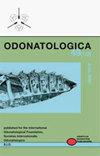中美洲和南美洲地区的Pantala flavescens缺乏遗传结构(Odinata:Libellulidae)
IF 0.4
4区 农林科学
Q4 ENTOMOLOGY
引用次数: 3
摘要
Pantala flavescens是地球上分布最广的植物,只有南极洲和欧洲部分地区没有。最近对mtDNA序列进行的一项研究表明,该物种在全球范围内存在一个泛型种群。然而,结合线粒体和核标记可以提供更多关于群体遗传变异性的信息。在这里,我们对COI基因片段进行了测序,并对8个微卫星位点进行了基因分型,以分析在中美洲(哥斯达黎加两个地点,相隔147公里)和南美洲两个地点(智利一个地点和秘鲁一个地点,相隔52公里)收集的个体的群体遗传结构和多样性。根据COI和微卫星数据估计的全球F-ST未显示遗传结构的证据。此外,利用COI和微卫星进行的分子方差分析(AMOVA)也没有发现遗传结构的证据,尽管两个地理区域之间的距离为5000公里。这些结果表明,黄斑蝶沿着美洲大陆进行了一次非同寻常的运动,从而证实了先前对该物种进行的研究。本文章由计算机程序翻译,如有差异,请以英文原文为准。
Lack of genetic structure in Pantala flavescens among Central and South American localities (Odonata: Libellulidae)
Pantala flavescens is the most widespread odonate on Earth, absent only in Antarctica and parts of Europe. A recent study performed with sequences of mtDNA suggested the presence of one panmictic population of the species at a global scale. However, combining mitochondrial and nuclear markers could offer more information about the genetic variability of populations. Here, we sequenced a fragment of the COI gene and genotyped eight microsatellite loci in order to analyze the population genetic structure and diversity in individuals collected in Central America (two sites in Costa Rica, separated by 147 km) and two localities in South America (one site in Chile and one in Peru, separated by 52 km). The global F-ST estimated from COI and microsatellite data showed no evidence of genetic structure. Furthermore, an Analysis of Molecular Variance (AMOVA) performed with both COI and microsatellites also showed no evidence of genetic structure despite the >5 000 km of distance between both geographic regions. These results suggest an extraordinary movement of P. flavescens along the American continent, thus corroborating the previous study conducted on this species.
求助全文
通过发布文献求助,成功后即可免费获取论文全文。
去求助
来源期刊

Odonatologica
生物-昆虫学
CiteScore
1.20
自引率
0.00%
发文量
1
审稿时长
>12 weeks
期刊介绍:
Odonatologica publishes original articles in all fields of odonatology. Review articles, i.e., original and critical accounts of important, rounded-off topics, are also explicitly welcome, but authors who plan to write a review should contact the Editor first.
 求助内容:
求助内容: 应助结果提醒方式:
应助结果提醒方式:


